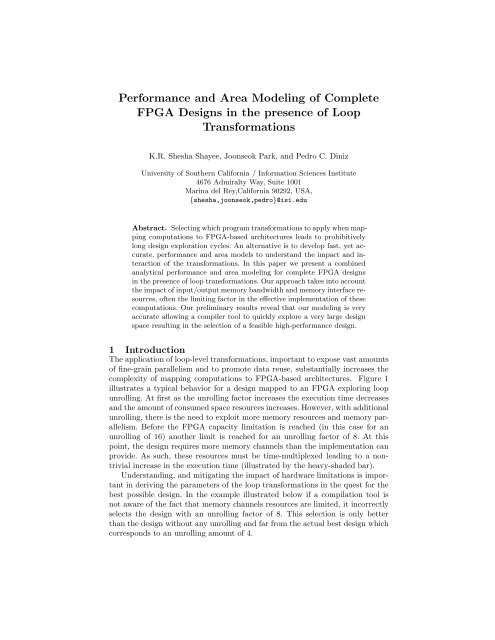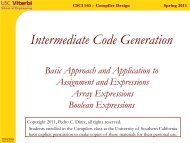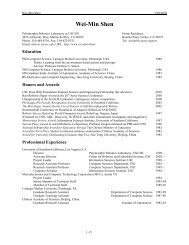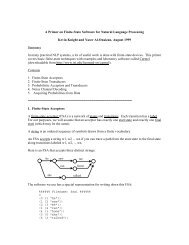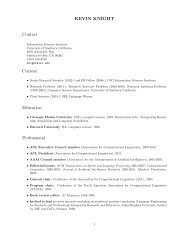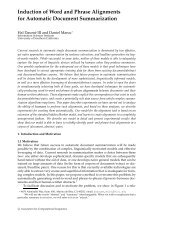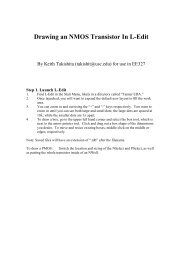Performance and Area Modeling of Complete FPGA Designs in the ...
Performance and Area Modeling of Complete FPGA Designs in the ...
Performance and Area Modeling of Complete FPGA Designs in the ...
You also want an ePaper? Increase the reach of your titles
YUMPU automatically turns print PDFs into web optimized ePapers that Google loves.
<strong>Performance</strong> <strong>and</strong> <strong>Area</strong> <strong>Model<strong>in</strong>g</strong> <strong>of</strong> <strong>Complete</strong><br />
<strong>FPGA</strong> <strong>Designs</strong> <strong>in</strong> <strong>the</strong> presence <strong>of</strong> Loop<br />
Transformations<br />
K.R. Shesha Shayee, Joonseok Park, <strong>and</strong> Pedro C. D<strong>in</strong>iz<br />
University <strong>of</strong> Sou<strong>the</strong>rn California / Information Sciences Institute<br />
4676 Admiralty Way, Suite 1001<br />
Mar<strong>in</strong>a del Rey,California 90292, USA,<br />
{shesha,joonseok,pedro}@isi.edu<br />
Abstract. Select<strong>in</strong>g which program transformations to apply when mapp<strong>in</strong>g<br />
computations to <strong>FPGA</strong>-based architectures leads to prohibitively<br />
long design exploration cycles. An alternative is to develop fast, yet accurate,<br />
performance <strong>and</strong> area models to underst<strong>and</strong> <strong>the</strong> impact <strong>and</strong> <strong>in</strong>teraction<br />
<strong>of</strong> <strong>the</strong> transformations. In this paper we present a comb<strong>in</strong>ed<br />
analytical performance <strong>and</strong> area model<strong>in</strong>g for complete <strong>FPGA</strong> designs<br />
<strong>in</strong> <strong>the</strong> presence <strong>of</strong> loop transformations. Our approach takes <strong>in</strong>to account<br />
<strong>the</strong> impact <strong>of</strong> <strong>in</strong>put/output memory b<strong>and</strong>width <strong>and</strong> memory <strong>in</strong>terface resources,<br />
<strong>of</strong>ten <strong>the</strong> limit<strong>in</strong>g factor <strong>in</strong> <strong>the</strong> effective implementation <strong>of</strong> <strong>the</strong>se<br />
computations. Our prelim<strong>in</strong>ary results reveal that our model<strong>in</strong>g is very<br />
accurate allow<strong>in</strong>g a compiler tool to quickly explore a very large design<br />
space result<strong>in</strong>g <strong>in</strong> <strong>the</strong> selection <strong>of</strong> a feasible high-performance design.<br />
1 Introduction<br />
The application <strong>of</strong> loop-level transformations, important to expose vast amounts<br />
<strong>of</strong> f<strong>in</strong>e-gra<strong>in</strong> parallelism <strong>and</strong> to promote data reuse, substantially <strong>in</strong>creases <strong>the</strong><br />
complexity <strong>of</strong> mapp<strong>in</strong>g computations to <strong>FPGA</strong>-based architectures. Figure 1<br />
illustrates a typical behavior for a design mapped to an <strong>FPGA</strong> explor<strong>in</strong>g loop<br />
unroll<strong>in</strong>g. At first as <strong>the</strong> unroll<strong>in</strong>g factor <strong>in</strong>creases <strong>the</strong> execution time decreases<br />
<strong>and</strong> <strong>the</strong> amount <strong>of</strong> consumed space resources <strong>in</strong>creases. However, with additional<br />
unroll<strong>in</strong>g, <strong>the</strong>re is <strong>the</strong> need to exploit more memory resources <strong>and</strong> memory parallelism.<br />
Before <strong>the</strong> <strong>FPGA</strong> capacity limitation is reached (<strong>in</strong> this case for an<br />
unroll<strong>in</strong>g <strong>of</strong> 16) ano<strong>the</strong>r limit is reached for an unroll<strong>in</strong>g factor <strong>of</strong> 8. At this<br />
po<strong>in</strong>t, <strong>the</strong> design requires more memory channels than <strong>the</strong> implementation can<br />
provide. As such, <strong>the</strong>se resources must be time-multiplexed lead<strong>in</strong>g to a nontrivial<br />
<strong>in</strong>crease <strong>in</strong> <strong>the</strong> execution time (illustrated by <strong>the</strong> heavy-shaded bar).<br />
Underst<strong>and</strong><strong>in</strong>g, <strong>and</strong> mitigat<strong>in</strong>g <strong>the</strong> impact <strong>of</strong> hardware limitations is important<br />
<strong>in</strong> deriv<strong>in</strong>g <strong>the</strong> parameters <strong>of</strong> <strong>the</strong> loop transformations <strong>in</strong> <strong>the</strong> quest for <strong>the</strong><br />
best possible design. In <strong>the</strong> example illustrated below if a compilation tool is<br />
not aware <strong>of</strong> <strong>the</strong> fact that memory channels resources are limited, it <strong>in</strong>correctly<br />
selects <strong>the</strong> design with an unroll<strong>in</strong>g factor <strong>of</strong> 8. This selection is only better<br />
than <strong>the</strong> design without any unroll<strong>in</strong>g <strong>and</strong> far from <strong>the</strong> actual best design which<br />
corresponds to an unroll<strong>in</strong>g amount <strong>of</strong> 4.
Fig. 1. Qualitative Execution <strong>and</strong> Space Plots <strong>in</strong> <strong>the</strong> Presence <strong>of</strong> Limited I/O Resources<br />
As this example illustrates, ignor<strong>in</strong>g <strong>the</strong> real memory <strong>in</strong>terface resource limitation<br />
can lead extremely poor design choices. Given <strong>the</strong> extremely large number<br />
<strong>of</strong> possible loop transformations <strong>and</strong> <strong>the</strong>ir <strong>in</strong>teraction, a solution to <strong>the</strong> problem<br />
<strong>of</strong> f<strong>in</strong>d<strong>in</strong>g <strong>the</strong> best perform<strong>in</strong>g (<strong>and</strong> feasible <strong>in</strong> terms <strong>of</strong> space) design is to<br />
develop performance <strong>and</strong> area estimation for <strong>the</strong> designs result<strong>in</strong>g from <strong>the</strong> application<br />
<strong>of</strong> a sequence <strong>of</strong> loop transformations. To this extend we focus on <strong>the</strong><br />
development <strong>of</strong> a set <strong>of</strong> analytical models comb<strong>in</strong>ed with behavioral estimation<br />
techniques for <strong>the</strong> performance <strong>and</strong> estimation <strong>of</strong> complete <strong>FPGA</strong> designs. In<br />
this work we model <strong>the</strong> application <strong>of</strong> a set <strong>of</strong> important loop transformations,<br />
unroll<strong>in</strong>g, til<strong>in</strong>g, <strong>and</strong> <strong>in</strong>terchange. We explicitly take <strong>in</strong>to account <strong>the</strong> impact <strong>of</strong><br />
<strong>the</strong> transformations on <strong>the</strong> limited resources <strong>of</strong> <strong>the</strong> design’s memory <strong>in</strong>terfaces.<br />
This paper makes <strong>the</strong> follow<strong>in</strong>g specific contributions:<br />
– It presents an area <strong>and</strong> performance model<strong>in</strong>g approach that comb<strong>in</strong>es analytical<br />
<strong>and</strong> estimation techniques for complete <strong>FPGA</strong> designs.<br />
– It describes <strong>the</strong> application <strong>of</strong> <strong>the</strong> proposed model<strong>in</strong>g to <strong>the</strong> mapp<strong>in</strong>g <strong>of</strong><br />
computations to <strong>FPGA</strong>s <strong>in</strong> <strong>the</strong> presence <strong>of</strong> loop unroll<strong>in</strong>g, til<strong>in</strong>g, <strong>in</strong>terchange<br />
<strong>and</strong> fission.<br />
– It validates <strong>the</strong> proposed model<strong>in</strong>g for a sample case study application on a<br />
real Xil<strong>in</strong>x Virtex TM <strong>FPGA</strong> device. This experience reveals our model to be<br />
very accurate even when deal<strong>in</strong>g with <strong>the</strong> vagaries <strong>of</strong> syn<strong>the</strong>sis tools.<br />
Overall this paper argues that performance <strong>and</strong> area model<strong>in</strong>g for complete<br />
designs, ei<strong>the</strong>r for <strong>FPGA</strong> or not, is an <strong>in</strong>strumental technique <strong>in</strong> h<strong>and</strong>l<strong>in</strong>g <strong>the</strong><br />
complexity <strong>of</strong> f<strong>in</strong>d<strong>in</strong>g effective solutions <strong>in</strong> <strong>the</strong> current reconfigurable as well as<br />
future architectures.<br />
This paper is organized as follows. In section 2 we describe <strong>the</strong> analysis <strong>and</strong><br />
model<strong>in</strong>g approach <strong>in</strong> detail. In section 3 we present experimental results for<br />
a sample image process<strong>in</strong>g kernel a b<strong>in</strong>ary image correlation. In section 4 we<br />
describe related work <strong>and</strong> conclude <strong>in</strong> section 5.<br />
2 <strong>Model<strong>in</strong>g</strong><br />
We now describe our analytical execution time <strong>and</strong> area model<strong>in</strong>g for complete<br />
designs as implemented <strong>in</strong> our target <strong>FPGA</strong> system.
2.1 Target Design Architecture <strong>and</strong> Execution Model<br />
The designs considered <strong>in</strong> our model<strong>in</strong>g are composed <strong>of</strong> two primary components<br />
as illustrated <strong>in</strong> Figure 2(a). The first component is <strong>the</strong> core datapath that<br />
implements <strong>the</strong> core <strong>of</strong> <strong>the</strong> computation <strong>and</strong> is generated by <strong>the</strong> syn<strong>the</strong>sis tools<br />
from a high-level description such as VHDL. This datapath is connected to an<br />
external memory via an memory <strong>in</strong>terface component. This memory <strong>in</strong>terface<br />
(see [1]) is responsible for generat<strong>in</strong>g <strong>the</strong> physical memory addresses <strong>of</strong> various<br />
data items as well as <strong>the</strong> electrical signal<strong>in</strong>g with <strong>the</strong> external memory.<br />
In many computations, such as image process<strong>in</strong>g kernels, <strong>the</strong>re is a substantial<br />
opportunity to reuse data <strong>in</strong> registers across iterations <strong>of</strong> a given loop. This<br />
is <strong>the</strong> case, for example, <strong>in</strong> w<strong>in</strong>dow-based algorithm <strong>in</strong> which a computation is<br />
performed over shifted w<strong>in</strong>dows <strong>of</strong> <strong>the</strong> same image. <strong>the</strong> overlap between w<strong>in</strong>dows<br />
allows for a subset <strong>of</strong> <strong>the</strong> data to be reused <strong>in</strong> registers, <strong>the</strong>refore avoid<strong>in</strong>g to<br />
load all <strong>of</strong> <strong>the</strong> data from memory. For computations with <strong>the</strong>se features, our<br />
datapath implementations <strong>in</strong>clude an <strong>in</strong>ternal tapped-delay l<strong>in</strong>e.<br />
Our model exploits <strong>the</strong> pipel<strong>in</strong>ed execution mode <strong>of</strong> memory accesses <strong>and</strong><br />
<strong>the</strong> core datapath. To adequately support this execution mode for <strong>the</strong> class <strong>of</strong><br />
regular image process<strong>in</strong>g computations, our memory <strong>in</strong>terface supports <strong>the</strong> concept<br />
<strong>of</strong> streamed data channels or simply streams. Associated with each <strong>of</strong> <strong>the</strong>se<br />
stream <strong>the</strong> memory <strong>in</strong>terface <strong>in</strong>clude resources to generate <strong>the</strong> correspond<strong>in</strong>g sequence<br />
<strong>of</strong> memory addresses. Sett<strong>in</strong>g up <strong>and</strong> reset<strong>in</strong>g <strong>the</strong>se resources whenever<br />
<strong>the</strong> datapath requires data from channels not currently set-up (or set up at a different<br />
base address <strong>in</strong> memory) <strong>in</strong>curs an overhead. The important parameters<br />
for <strong>the</strong> peformance model<strong>in</strong>g <strong>of</strong> <strong>the</strong> pipel<strong>in</strong>ed execution mode <strong>of</strong> <strong>the</strong> datapath<br />
are its <strong>in</strong>itiation <strong>in</strong>terval <strong>and</strong> latency. As to <strong>the</strong> memory <strong>in</strong>terface, its important<br />
parameters are <strong>the</strong> reload<strong>in</strong>g overhead, <strong>the</strong> read <strong>and</strong> write latencies <strong>and</strong> <strong>the</strong> setup<br />
for read<strong>in</strong>g <strong>and</strong> writ<strong>in</strong>g <strong>in</strong> pipel<strong>in</strong>ed memory access mode.<br />
Fig. 2. (a) <strong>FPGA</strong> Design Architecture (b) Execution Mode<br />
Figure 2(b) illustrates <strong>the</strong> basic parameters <strong>of</strong> <strong>the</strong> execution model, which<br />
will be <strong>the</strong> basic parameters for <strong>the</strong> performance model<strong>in</strong>g described <strong>in</strong> <strong>the</strong> next<br />
section. We show a 2-channel implementation with 2 buffers <strong>in</strong> <strong>the</strong> datapath,<br />
each with a depth <strong>of</strong> 4 elements <strong>and</strong> correspond<strong>in</strong>g to 2 datapath <strong>in</strong>put ports.<br />
The computation executes 4 loop iterations per block <strong>of</strong> data read from memory.<br />
2.2 <strong>Performance</strong> <strong>Model<strong>in</strong>g</strong><br />
As with o<strong>the</strong>r compile-time model<strong>in</strong>g approaches we assume known compiletime<br />
loop bounds. In addition we assume that <strong>in</strong> <strong>the</strong> presence <strong>of</strong> control-flow
<strong>the</strong> expressions must capture <strong>the</strong> longer execution path <strong>and</strong> that <strong>the</strong> datapath<br />
implementation will preemptively fetch all <strong>of</strong> <strong>the</strong> data items required <strong>in</strong> each<br />
<strong>of</strong> <strong>the</strong> possible control paths. While <strong>in</strong> general <strong>the</strong>se assumptions would lead to<br />
excessively <strong>in</strong>flated performance results, for <strong>the</strong> target set <strong>of</strong> digital image applications,<br />
<strong>and</strong> due to <strong>the</strong>ir amenability to be modeled <strong>in</strong>to perfectly loop nests<br />
without severe control flow, this potential phenomenon is rare, if at all observed.<br />
Under <strong>the</strong>se assumptions we split <strong>the</strong> overall execution <strong>in</strong>to 5 components summarized<br />
below <strong>and</strong> whose analytical expressions are presented below.<br />
Comp = LoopCnt ∗ <strong>in</strong>itInter<br />
NSO = �<br />
0≤i≤m LoopCntNS i ∗ CC NS<br />
P O = �<br />
MO = �<br />
0≤i≤m LoopCntMem i ∗ CC Mem<br />
Exec = (Comp + NSO + MO + P O) ∗ Clk<br />
0≤i≤m LoopCntPi ∗ max(BD B DP read<br />
j ) ∗ CC<br />
Computation Time (Comp) models <strong>the</strong> aggregate time <strong>the</strong> datapath<br />
spends actively comput<strong>in</strong>g results. We def<strong>in</strong>e it as <strong>the</strong> product <strong>of</strong> <strong>the</strong> overall<br />
number <strong>of</strong> iterations times <strong>the</strong> datapath <strong>in</strong>itiation <strong>in</strong>terval.<br />
Non-Stream<strong>in</strong>g Access Overhead (NSO) models <strong>the</strong> aggregate overhead<br />
<strong>in</strong> <strong>the</strong> reload<strong>in</strong>g <strong>of</strong> <strong>the</strong> base <strong>and</strong> <strong>of</strong>fset for non-stream<strong>in</strong>g memory accesses <strong>and</strong><br />
is def<strong>in</strong>ed by <strong>the</strong> NSO expression. In this expression LoopCntNS i captures <strong>the</strong><br />
number <strong>of</strong> iterations <strong>the</strong> datapath performs a non-stream<strong>in</strong>g memory accesses;<br />
<strong>and</strong> CC NS is <strong>the</strong> <strong>in</strong>dividual cost <strong>of</strong> such accesses. The value m is <strong>the</strong> total<br />
number <strong>of</strong> array variables <strong>in</strong> <strong>the</strong> particular implementation with non-stream<strong>in</strong>g<br />
accesses. For stream<strong>in</strong>g memory access this metric is def<strong>in</strong>ed as 0.<br />
Prologue Overhead (PO) models <strong>the</strong> overhead <strong>of</strong> fill<strong>in</strong>g buffers associated<br />
with a data stream before <strong>the</strong> datapath is ready to start its pipel<strong>in</strong>ed execution.<br />
The component P O def<strong>in</strong>ed above captures this cost <strong>of</strong> buffer preload<strong>in</strong>g where<br />
corresponds to <strong>the</strong> iteration count <strong>of</strong> <strong>the</strong> transformed loop nest that<br />
LoopCntP i<br />
requires prologue load<strong>in</strong>g. BDB i is <strong>the</strong> buffer depth <strong>of</strong> <strong>the</strong> B buffer (<strong>in</strong> <strong>the</strong> datapath)<br />
for variable i. The factor max(BDB i ) def<strong>in</strong>es <strong>the</strong> maximum length <strong>of</strong> time<br />
required to fill <strong>the</strong> longest buffer.<br />
Memory access overhead (MO) models <strong>the</strong> latency on <strong>the</strong> memory <strong>in</strong>terface<br />
for retriev<strong>in</strong>g data from <strong>the</strong> memory. In <strong>the</strong> MO expression LC Mem<br />
i is <strong>the</strong><br />
ratio <strong>of</strong> <strong>the</strong> number <strong>of</strong> memory accesses (or loop count account<strong>in</strong>g <strong>the</strong> memory<br />
access) to that <strong>of</strong> <strong>the</strong> granularity, for a variable i. Granularity is def<strong>in</strong>ed as <strong>the</strong><br />
ratio <strong>of</strong> <strong>the</strong> data width <strong>of</strong> memory access to that <strong>of</strong> <strong>the</strong> data consumed <strong>in</strong> <strong>the</strong><br />
datapath. Granularity is 1 if <strong>the</strong> data width <strong>of</strong> <strong>the</strong> memory access is <strong>the</strong> same<br />
as that <strong>of</strong> <strong>the</strong> data consumed <strong>in</strong> <strong>the</strong> datapath. CC Mem is <strong>the</strong> number <strong>of</strong> cycles<br />
required for a memory data access.<br />
Clock rate (Clk) We <strong>in</strong>clude this metric <strong>in</strong> <strong>the</strong> evaluation <strong>of</strong> <strong>the</strong> performance<br />
<strong>of</strong> a design as different designs will have can exhibit a wide disparity <strong>of</strong><br />
clock rates due to radically different <strong>in</strong>ternal hardware implementations. Conduct<strong>in</strong>g<br />
relative comparison based on <strong>the</strong> clock cycles alone could lead to <strong>the</strong><br />
wrong decision <strong>in</strong> select<strong>in</strong>g <strong>the</strong> best perform<strong>in</strong>g design.
Execution Time (Exec) simply def<strong>in</strong>es <strong>the</strong> aggregate execution time <strong>and</strong><br />
is simply <strong>the</strong> product <strong>of</strong> <strong>the</strong> number <strong>of</strong> execution cycles with <strong>the</strong> actual values<br />
<strong>of</strong> Clk as derived from <strong>the</strong> syn<strong>the</strong>sis tools.<br />
2.3 <strong>Area</strong> <strong>Model<strong>in</strong>g</strong><br />
This model<strong>in</strong>g is essential so that a compiler can use <strong>the</strong> area estimates derived<br />
from <strong>the</strong> syn<strong>the</strong>sis tool <strong>and</strong> comb<strong>in</strong>e <strong>the</strong> predicted area for <strong>the</strong> memory <strong>in</strong>terface<br />
when judg<strong>in</strong>g <strong>the</strong> area <strong>of</strong> a complete <strong>FPGA</strong> design.<br />
To achieve this goal, we have derived a l<strong>in</strong>ear model us<strong>in</strong>g l<strong>in</strong>ear regression for<br />
a set <strong>of</strong> data po<strong>in</strong>ts for various choices <strong>of</strong> number <strong>of</strong> memory <strong>in</strong>terface channels.<br />
For 32-bit wide data channels <strong>the</strong> overall <strong>FPGA</strong> (Xil<strong>in</strong>x Virtex TM 1K device)<br />
area (<strong>in</strong> slices) for <strong>the</strong> memory <strong>in</strong>terface can be approximated by <strong>the</strong> expression<br />
<strong>Area</strong>32 = 137 ∗ NumberChannels + 1514. A similar empirical approach can be<br />
used for o<strong>the</strong>r channels widths <strong>and</strong> <strong>FPGA</strong> devices.<br />
As to <strong>the</strong> model<strong>in</strong>g <strong>of</strong> <strong>the</strong> area for <strong>the</strong> datapath we use estimation results<br />
provided by syn<strong>the</strong>sis tools such as <strong>the</strong> Mentor Graphics’ Monet TM tool. The<br />
overall area estimation <strong>the</strong>refore comb<strong>in</strong>es <strong>the</strong> empirical model for <strong>the</strong> memory<br />
<strong>in</strong>terface with <strong>the</strong> syn<strong>the</strong>sis estimates.<br />
2.4 Deriv<strong>in</strong>g <strong>the</strong> Model Parameters<br />
In <strong>the</strong> current implementation we manually apply <strong>the</strong> various loop transformations,<br />
<strong>and</strong> derive <strong>the</strong> parameters <strong>of</strong> our model<strong>in</strong>g effort are derived us<strong>in</strong>g a crude<br />
emulation <strong>of</strong> <strong>the</strong> actual execution by actually runn<strong>in</strong>g <strong>the</strong> computation <strong>in</strong> s<strong>of</strong>tware<br />
<strong>and</strong> accumulat<strong>in</strong>g <strong>the</strong> number <strong>of</strong> occurrences <strong>of</strong> each metric. We are <strong>in</strong><br />
<strong>the</strong> process <strong>of</strong> automat<strong>in</strong>g <strong>the</strong> application <strong>of</strong> <strong>the</strong> transformations <strong>and</strong> develop<strong>in</strong>g<br />
more sophisticated, <strong>and</strong> automated, approach to extract <strong>the</strong> values <strong>of</strong> <strong>the</strong><br />
model<strong>in</strong>g parameters.<br />
The model<strong>in</strong>g parameters that depend on <strong>the</strong> target <strong>FPGA</strong> device such as <strong>the</strong><br />
maximum clock rate or <strong>the</strong> actual implementation <strong>of</strong> <strong>the</strong> memory <strong>in</strong>terfaces (e.g.,<br />
<strong>the</strong> latency or <strong>the</strong> number <strong>of</strong> cycles for non-pipel<strong>in</strong>ed operations) are architecture<br />
dependent <strong>and</strong> known at compile time. The rema<strong>in</strong><strong>in</strong>g model parameters are<br />
ei<strong>the</strong>r derived from analysis <strong>of</strong> <strong>the</strong> source code, as is <strong>the</strong> case <strong>of</strong> <strong>the</strong> classification<br />
<strong>of</strong> which array data accesses are non-sequential, where <strong>the</strong> compiler can use data<br />
dependence analysis as described <strong>in</strong> [2].<br />
3 Case Study: B<strong>in</strong>ary Image Correlation<br />
We now validate <strong>the</strong> proposed performance <strong>and</strong> area model<strong>in</strong>g for one image<br />
process<strong>in</strong>g kernel — a b<strong>in</strong>ary image correlation (BIC) computation.<br />
3.1 Orig<strong>in</strong>al Computation <strong>and</strong> Role <strong>of</strong> Loop Transformations<br />
Figure 3 depicts <strong>the</strong> pseudo-code for <strong>the</strong> example under study. This computation<br />
consists <strong>of</strong> a 4-loop nest with known loop bounds <strong>and</strong> implements b<strong>in</strong>ary image<br />
correlation us<strong>in</strong>g a mask variable (2D mask array) over an <strong>in</strong>put image (2D image<br />
array). The computation scans <strong>the</strong> <strong>in</strong>put image by slid<strong>in</strong>g an e × e w<strong>in</strong>dow over
<strong>the</strong> <strong>in</strong>put <strong>and</strong> accumulates <strong>the</strong> values <strong>of</strong> <strong>the</strong> correspond<strong>in</strong>g image w<strong>in</strong>dow for<br />
non-zero mask values <strong>in</strong> th (ano<strong>the</strong>r 2D array variable).<br />
The <strong>in</strong>put image(image[m+i][n+j]) is accessed <strong>in</strong> a row-wise fashion. Unroll<strong>in</strong>g<br />
<strong>the</strong> j-loop fully, e − 1 <strong>of</strong> <strong>the</strong> e values <strong>in</strong> a s<strong>in</strong>gle row, can be reused <strong>in</strong><br />
consecutive iterations <strong>of</strong> <strong>the</strong> n-loop if <strong>the</strong> e values are stored <strong>in</strong> a tapped-delay<br />
l<strong>in</strong>e. And, as <strong>the</strong> data access is row-wise, unroll<strong>in</strong>g <strong>of</strong> <strong>the</strong> i-loop enhances <strong>the</strong><br />
performance by <strong>in</strong>creas<strong>in</strong>g <strong>the</strong> reuse to 2 dimensions. As a consequence, after<br />
<strong>the</strong> first iteration(where e×e data are loaded), only e data values correspond<strong>in</strong>g<br />
e data streams needs to be loaded <strong>in</strong> <strong>the</strong> sub-sequent iterations <strong>of</strong> <strong>the</strong> n-loop.<br />
for m = 0 to m < (t-e)<br />
for n = 0 to n < (t-e)<br />
for i = 0 to i < e<br />
for j = 0 to j < e<br />
if(mask[i][j] != 0)<br />
th[m][n] += image[m+i][n+j];<br />
(a) Orig<strong>in</strong>al code.<br />
for m = 0 to m < t<br />
for q = 0 to q < t by e<br />
for p = 0 to p < s by f<br />
for n = q to e-1<br />
for i = p to p+f-1 // unrolled loop<br />
if(mask[i][0] != 0)<br />
th[m][n] += image[m+i][n];<br />
...<br />
if(mask[i][s-1] != 0)<br />
th[m][n] += image[m+i][n+s-1];<br />
(b) Us<strong>in</strong>g e × f til<strong>in</strong>g.<br />
for p = 0 to s/k<br />
for m = 0 to t<br />
for n = 0 to t<br />
for i = p*(s/k) to p*(s/k)+k // fully unrolled<br />
for j = 0 to s // fully unrolled<br />
if(mask[i][j] != 0)<br />
temp[p][m][n] += image[m+i][n+j];<br />
// loop-fission <strong>and</strong> loop <strong>in</strong>terchange<br />
for m = 0 to t<br />
for n = 0 to t<br />
for p = 0 to s/k // fully unrolled<br />
th[m][n] += temp[p][m][n];<br />
(c) Loop fission after <strong>in</strong>terchange (loops m <strong>and</strong> p)<br />
Fig. 3. BIC codes after apply<strong>in</strong>g loop transformations.<br />
Full unroll<strong>in</strong>g <strong>of</strong> <strong>the</strong> two <strong>in</strong>ner most loops, as suggested above, may not<br />
always be possible as unroll<strong>in</strong>g leads to <strong>the</strong> replication <strong>of</strong> <strong>the</strong> loop body operators<br />
generat<strong>in</strong>g very large designs. As such we can apply til<strong>in</strong>g <strong>of</strong> <strong>the</strong> <strong>in</strong>nermost<br />
loops as illustrated <strong>in</strong> Figure 3(b). By til<strong>in</strong>g <strong>the</strong> i <strong>and</strong> j-loops by a factor <strong>of</strong><br />
e <strong>and</strong> f respectively, we reduce <strong>the</strong> amount <strong>of</strong> hardware resources devoted to<br />
<strong>the</strong> datapath. The trade-<strong>of</strong>f, however, is <strong>in</strong> terms <strong>of</strong> reduced reuse. The tappeddelay<br />
l<strong>in</strong>es that, <strong>in</strong> case <strong>of</strong> unroll<strong>in</strong>g, held <strong>the</strong> data <strong>of</strong> a row <strong>of</strong> image, now holds<br />
data <strong>of</strong> length e. But, <strong>of</strong> greater significance is <strong>the</strong> fact that <strong>the</strong> exectution time<br />
<strong>in</strong>creases as <strong>the</strong> memory <strong>in</strong>terface resources, associated with address generation,<br />
requires reload<strong>in</strong>g <strong>of</strong> address (<strong>and</strong> as a consequence <strong>in</strong>creased data access) for<br />
<strong>the</strong> data streams associated with each tile. The performance <strong>of</strong> <strong>the</strong> overall design<br />
is thus substantially reduced.<br />
In <strong>the</strong> presence <strong>of</strong> associative operations it is possible to use loop <strong>in</strong>terchange<br />
with loop til<strong>in</strong>g to avoid <strong>the</strong> need <strong>of</strong> reload<strong>in</strong>g <strong>the</strong> data <strong>in</strong> a tile. The implementation<br />
saves partial results <strong>of</strong> <strong>the</strong> computation <strong>in</strong> temporary datapath buffers<br />
<strong>the</strong>reby avoid<strong>in</strong>g <strong>the</strong> need to reload data from external memory. This strategy<br />
comes at <strong>the</strong> cost <strong>of</strong> a, potentially large, multi-dimensional array for stor<strong>in</strong>g <strong>the</strong><br />
partial results <strong>in</strong> <strong>the</strong> datapath. The size <strong>of</strong> this temporary array is <strong>in</strong> <strong>the</strong> order<br />
<strong>of</strong> <strong>the</strong> <strong>in</strong>put image size, mak<strong>in</strong>g it an <strong>in</strong>feasible solution for most cases.
To mitigate this issue <strong>of</strong> buffer space, we use yet ano<strong>the</strong>r set <strong>of</strong> transformation:<br />
array privatization (to privatize temporal variable) <strong>and</strong> loop fission. The<br />
privatized temporal value is now stored <strong>in</strong> <strong>the</strong> external memory ra<strong>the</strong>r <strong>in</strong>ternal<br />
buffers (we pay <strong>the</strong> price for memory access). A second loop generates f<strong>in</strong>al<br />
results by add<strong>in</strong>g up temporal values <strong>in</strong> <strong>the</strong> correct order.<br />
The application <strong>of</strong> <strong>the</strong>se 3 loop transformations to this case study illustrates<br />
<strong>the</strong> po<strong>in</strong>t <strong>of</strong> this paper. As <strong>the</strong>se transformations affect <strong>the</strong> data reuse patterns<br />
<strong>and</strong>, <strong>in</strong> turn, <strong>the</strong> way <strong>the</strong> data needs to be streamed <strong>in</strong> <strong>and</strong> out <strong>of</strong> <strong>the</strong> correspond<strong>in</strong>g<br />
datapath implementation, <strong>the</strong> overall performance <strong>in</strong> <strong>FPGA</strong>-based<br />
implementations is not only affected by <strong>the</strong> number <strong>of</strong> iterations executed but<br />
also, <strong>and</strong> <strong>in</strong>fact more significantly, by <strong>the</strong> number <strong>of</strong> times <strong>the</strong> memory <strong>in</strong>terface<br />
resources need to reset.<br />
3.2 Experimental Results<br />
We have manually derived behavioral specification for <strong>the</strong> BIC code apply<strong>in</strong>g <strong>the</strong><br />
loop transformations described above for a variety <strong>of</strong> parameter choices. We <strong>the</strong>n<br />
use Mentor Graphics’ Monet high-level syn<strong>the</strong>sis tool to derive <strong>the</strong> structural<br />
VHDL specification <strong>and</strong> obta<strong>in</strong> <strong>the</strong> estimated area <strong>and</strong> <strong>in</strong>itiation <strong>in</strong>terval <strong>and</strong><br />
latency for <strong>the</strong>ir pipel<strong>in</strong>ed implementation. To derive a complete design we merge<br />
<strong>the</strong> structural VHDL with <strong>the</strong> structural code <strong>of</strong> <strong>the</strong> memory channel <strong>in</strong>terfaces.<br />
Given a complete VHDL design we used Synplicity Synplify Pro 6.2 <strong>and</strong> Xil<strong>in</strong>x<br />
ISE 4.1i tool sets for logic syn<strong>the</strong>sis <strong>and</strong> Place-<strong>and</strong>-Route (P&R) [3] target<strong>in</strong>g a<br />
Xil<strong>in</strong>x Virtex TM XCV 1000 BG560 device.<br />
<strong>Performance</strong> Model Validation We validate <strong>the</strong> performance model<strong>in</strong>g describe<br />
<strong>in</strong> section 2 for <strong>the</strong> VHDL code result<strong>in</strong>g from <strong>the</strong> application <strong>of</strong> <strong>the</strong><br />
various loop transformations described above. In this model<strong>in</strong>g we use <strong>the</strong> numerical<br />
parameters as, CC DP Read = 2, CC Mem = 7 <strong>and</strong> CC NS = 3 <strong>and</strong> omit<br />
<strong>the</strong> symbolic loop expressions here for space considerations.<br />
Figure 4 plots <strong>the</strong> measured vs. predicted performance for <strong>the</strong> various, loop<br />
unrolled (for <strong>the</strong> <strong>in</strong>ner loop); tiled (<strong>the</strong> i <strong>and</strong> j loops <strong>and</strong> tiled-with-<strong>in</strong>terchange.<br />
The vertical axis corresponds to <strong>the</strong> simulated clock cycle counts. We limit our<br />
experimental set to til<strong>in</strong>g versions <strong>of</strong> 1 × f because o<strong>the</strong>r transformations do not<br />
deliver additional performance.<br />
These results <strong>in</strong>dicate that our performance model<strong>in</strong>g tracks <strong>the</strong> overall performance<br />
for <strong>the</strong> various implementations very well. The gap between <strong>the</strong> predicted<br />
performance <strong>and</strong> simulation results is due to our channel controller behavior.<br />
The channel controller used <strong>in</strong> our memory <strong>in</strong>terface uses a round-rob<strong>in</strong><br />
schedul<strong>in</strong>g strategy which <strong>in</strong>troduces a small number <strong>of</strong> additional cycles, as we<br />
verified through simulation.<br />
<strong>Area</strong> <strong>and</strong> Implementation results We now validate <strong>the</strong> overall area estimation<br />
approach us<strong>in</strong>g <strong>the</strong> empirical model for <strong>the</strong> memory <strong>in</strong>terface <strong>and</strong> <strong>the</strong> area<br />
estimation extracted from behavioral syn<strong>the</strong>sis. In this validation we compare<br />
<strong>the</strong> results a compiler would obta<strong>in</strong> <strong>of</strong>f-l<strong>in</strong>e (i.e., without actually syn<strong>the</strong>siz<strong>in</strong>g<br />
any designs) with <strong>the</strong> real results syn<strong>the</strong>siz<strong>in</strong>g <strong>the</strong> actual complete designs.
80.0x10 6<br />
Execution Cycles<br />
60.0x10 6<br />
40.0x10 6<br />
20.0x10 6<br />
8.0x10 6<br />
Execution Cycles<br />
8.0x10 6<br />
Unrolled Tiled Execution Cycles Tiled & Interchanged<br />
Simulation<br />
Estimation<br />
6.0x10 6<br />
4.0x10 6<br />
2.0x10 6<br />
0.0x10<br />
1x16 2x16 4x16 8x16 16x16 2x16x16 4x16x16 8x16x16<br />
0<br />
0.0x10<br />
unroll<strong>in</strong>g (nxi) loop, j loop fully unrolled<br />
0<br />
Simulation<br />
Estimation<br />
1x16 2x16 4x16 8x16 16x16<br />
til<strong>in</strong>g <strong>of</strong> i loop <strong>and</strong> j loop<br />
6.0x10 6<br />
4.0x10 6<br />
2.0x10 6<br />
0.0x10 0<br />
Simulation<br />
Estimation<br />
1x16 2x16 4x16 8x16 16x16<br />
til<strong>in</strong>g <strong>of</strong> i loop <strong>and</strong> j loop <strong>and</strong> <strong>in</strong>terchange<br />
Fig. 4. <strong>Performance</strong> Estimation .vs. Simulation Results for BIC.<br />
Table 1 presents <strong>the</strong> syn<strong>the</strong>sis results <strong>and</strong> complete design results for <strong>the</strong><br />
various tilled <strong>and</strong> tiled&<strong>in</strong>terchange designs. For <strong>the</strong> tiled&<strong>in</strong>terchange design we<br />
present here only <strong>the</strong> design correspond<strong>in</strong>g to <strong>the</strong> first loop that carries out <strong>the</strong><br />
bulk <strong>of</strong> <strong>the</strong> computation. <strong>Area</strong> estimates produced by Monet behavioral syn<strong>the</strong>sis<br />
tool are not compatible, <strong>in</strong> terms <strong>of</strong> units, with those <strong>of</strong> <strong>the</strong> P&R tools. However,<br />
<strong>the</strong>se estimates to a large extent do capture <strong>the</strong> ’trend’ <strong>of</strong> <strong>the</strong> results(area)<br />
produced by <strong>the</strong> syn<strong>the</strong>sis <strong>and</strong> P&R tools as is evident from table 1. Table 1<br />
compares <strong>the</strong> estimation numbers with those <strong>of</strong> <strong>the</strong> syn<strong>the</strong>sis <strong>and</strong> P&R numbers<br />
for <strong>the</strong> tiled implementations. Estimation numbers for datapath <strong>and</strong> <strong>in</strong>terfaces<br />
are provided <strong>in</strong> columns 2 <strong>and</strong> 4 while columns 3 <strong>and</strong> 6 are <strong>the</strong> syn<strong>the</strong>sis <strong>and</strong><br />
P&R results for datapath only <strong>and</strong> full design (datapath+<strong>in</strong>terface) respectively.<br />
Column 5 is <strong>the</strong> estimation number for <strong>the</strong> full design (col. 2 + col. 4).<br />
Datapath Only Interface Full Design<br />
Estimates P&R Estimates Estimates P&R<br />
Tile (Monet) (Slices) (Monet) (Monet) Slices(%) Clk<br />
(MHz)<br />
(1x1) 14621 4214 1788 16409 4558 (37) 35.3<br />
(1x2) 15804 3808 2602 18406 6661 (54) 29.9<br />
(1x4) 18191 5163 2610 20801 7070 (57) 21.7<br />
(1x8) 22868 6369 3706 26574 9734 (79) 28.3<br />
(1x16) 19704 5053 5898 25602 10417 (84) 24.2<br />
Datapath Only Interface Full Design<br />
Estimates P&R Estimates Estimates P&R<br />
Tile (Monet) (Slices) (Monet) (Monet) Slices(%) Clk<br />
(MHz)<br />
(1x1) 1411.1 408 1788 3199.1 2326 (19) 43.4<br />
(1x2) 2599.1 725 2602 5201.1 2984 (24) 36.1<br />
(1x4) 4963.1 1333 2610 7573.1 4038 (33) 26.6<br />
(1x8) 9694.9 2620 3706 13400.9 6119 (50) 16.7<br />
(1x16) 19704.0 5053 5898 25602.0 10417 (84) 24.2<br />
Table 1. Syn<strong>the</strong>sis results for til<strong>in</strong>g (top) <strong>and</strong> til<strong>in</strong>g with <strong>in</strong>terchang<strong>in</strong>g <strong>and</strong> fission (bottom).<br />
As can be seen <strong>the</strong> comb<strong>in</strong>ed estimation results for <strong>the</strong> complete designs<br />
track very well <strong>the</strong> real area results even for <strong>the</strong> very large designs that occupy<br />
more than 50% <strong>of</strong> <strong>the</strong> <strong>FPGA</strong> area. This is important as <strong>the</strong> application <strong>of</strong> loop<br />
transformations that expose vast amount <strong>of</strong> <strong>in</strong>struction level parallelism require<br />
<strong>the</strong> replication <strong>of</strong> functional operators <strong>and</strong> <strong>in</strong>variably lead to large designs. For<br />
some <strong>of</strong> <strong>the</strong> implementations <strong>the</strong> <strong>in</strong>ternal tapped-delay l<strong>in</strong>es used to reduce <strong>the</strong><br />
number <strong>of</strong> memory accesses is an important factor on <strong>the</strong> area as well.
We <strong>in</strong>vestigated <strong>the</strong> fact that <strong>the</strong> (1 × 8) tiled-version maps to more slices<br />
than <strong>the</strong> (1 × 16) version (see table 1 (top) col. 3). We concluded that although<br />
<strong>the</strong> computational for <strong>the</strong> (1 × 8) version are approximately half <strong>of</strong> those for <strong>the</strong><br />
(1 × 16) version, <strong>the</strong> area consumed by <strong>the</strong> registers used to store <strong>in</strong>termediate<br />
results across <strong>the</strong> m-loop were responsible for this area anomaly.<br />
3.3 Discussion<br />
Experimental results reveal that our performance <strong>and</strong> area model<strong>in</strong>g correlates<br />
well with our simulation/syn<strong>the</strong>sis results for various implementations <strong>of</strong> BIC.<br />
Our performance model is capable <strong>of</strong> identify<strong>in</strong>g effects <strong>of</strong> various loop transformations,<br />
which ultimately lead to <strong>the</strong> best comb<strong>in</strong>ation <strong>of</strong> loop transformations.<br />
In <strong>the</strong> BIC case study our model accurately captures <strong>the</strong> effect <strong>of</strong> til<strong>in</strong>g with<br />
different til<strong>in</strong>g factors, <strong>and</strong> we can f<strong>in</strong>d <strong>the</strong> best til<strong>in</strong>g shape/s. The results also<br />
reveal that our model<strong>in</strong>g successfully captures <strong>the</strong> performance behavior <strong>of</strong> <strong>the</strong><br />
more sophisticated comb<strong>in</strong>ation <strong>of</strong> loop <strong>in</strong>terchange, fission <strong>and</strong> privatization.<br />
Overall, we believe <strong>the</strong> model<strong>in</strong>g approach described <strong>in</strong> this paper to be<br />
applicable to a wider range <strong>of</strong> reconfigurable architectures as our model does<br />
not exploit any feature <strong>of</strong> <strong>the</strong> underly<strong>in</strong>g architecture. In fact, our case study<br />
reveals that <strong>the</strong> major source <strong>of</strong> discrepancies was ei<strong>the</strong>r due to characteristics<br />
<strong>of</strong> <strong>FPGA</strong> syn<strong>the</strong>sis (e.g. <strong>the</strong> large impact <strong>of</strong> temporary buffers) or due to <strong>FPGA</strong><br />
implementation execution features (e.g., schedul<strong>in</strong>g <strong>of</strong> memory accesses).<br />
4 Related Work<br />
O<strong>the</strong>r researchers have also recognized <strong>the</strong> need for fast area <strong>and</strong> performance estimation<br />
to guide <strong>the</strong> application <strong>of</strong> compiler high-level loop transformations for<br />
deriv<strong>in</strong>g alternative designs. Derrien <strong>and</strong> S. Rajoupadyhe[4] describe a processor<br />
array partition<strong>in</strong>g that takes <strong>in</strong>to account <strong>the</strong> memory hierarchy <strong>and</strong> I/O b<strong>and</strong>width<br />
<strong>and</strong> apply til<strong>in</strong>g to maximize <strong>the</strong> performance <strong>of</strong> <strong>the</strong> mapp<strong>in</strong>g <strong>of</strong> a loop<br />
nest onto <strong>FPGA</strong>-based architectures. In this context <strong>the</strong>y use an analytical performance<br />
model to determ<strong>in</strong>e <strong>the</strong> best tile size. So et. al. [5] have exp<strong>and</strong>ed <strong>the</strong><br />
loop transformations to <strong>in</strong>clude unroll<strong>in</strong>g <strong>and</strong> use behavioral syn<strong>the</strong>sis estimates<br />
directly from commercially available syn<strong>the</strong>sis tools <strong>in</strong> an <strong>in</strong>tegrated compilation<br />
<strong>and</strong> syn<strong>the</strong>sis. The PICO project [6] takes functions def<strong>in</strong>ed as C loop nests<br />
to a synchronous array <strong>of</strong> customizable VLIW processors. PICO uses estimates<br />
from its schedul<strong>in</strong>g <strong>of</strong> <strong>the</strong> iterations <strong>of</strong> <strong>the</strong> nest to determ<strong>in</strong>e which loop transformation(s)<br />
lead to shorter schedul<strong>in</strong>g time <strong>and</strong> <strong>the</strong>refore m<strong>in</strong>imal completion<br />
time. The MILAN project [7] provides design space exploration <strong>and</strong> simulation<br />
environments for System-on-Chip(SoC) architecture. MILAN evaluates several<br />
possible partitions <strong>of</strong> <strong>the</strong> computation among <strong>the</strong> various system components<br />
(processor, memory, special purposed accelerators) us<strong>in</strong>g simulation techniques<br />
to derive estimates used <strong>in</strong> <strong>the</strong> evaluation <strong>of</strong> a given application mapp<strong>in</strong>g.<br />
The work presented <strong>in</strong> this paper differs from <strong>the</strong>se approaches <strong>in</strong> several<br />
respects. While o<strong>the</strong>r projects have focused on more general computation we<br />
have focused on <strong>the</strong> doma<strong>in</strong> <strong>of</strong> image process<strong>in</strong>g algorithms specified as tight<br />
loop nests. Second, ra<strong>the</strong>r than us<strong>in</strong>g pr<strong>of</strong>il<strong>in</strong>g or simulation based estimates we
have analytically modeled <strong>the</strong> performance <strong>and</strong> relied on <strong>the</strong> accuracy <strong>of</strong> behavioral<br />
syn<strong>the</strong>sis estimation commercial tools for area model<strong>in</strong>g. In terms <strong>of</strong> loop<br />
transformations we have focused not only on loop unroll<strong>in</strong>g <strong>and</strong> til<strong>in</strong>g but also<br />
on loop <strong>in</strong>terchange <strong>in</strong> <strong>the</strong> presence <strong>of</strong> associative operators. Loop <strong>in</strong>terchang<strong>in</strong>g<br />
<strong>in</strong>troduces <strong>the</strong> complication <strong>of</strong> hav<strong>in</strong>g to save <strong>in</strong>termediate results for subsequent<br />
computations. <strong>Designs</strong> with large set <strong>of</strong> registers for temporary values lead to<br />
an explosion <strong>of</strong> area <strong>and</strong> substantial degradation <strong>of</strong> clock estimates.<br />
5 Conclusion<br />
In this paper we presented a performance <strong>and</strong> area model<strong>in</strong>g approach us<strong>in</strong>g analytical<br />
<strong>and</strong> empirical techniques for complete <strong>FPGA</strong> designs. Our model<strong>in</strong>g is<br />
geared towards computations expressed as loop nests <strong>in</strong> high-level programm<strong>in</strong>g<br />
languages such as C. Us<strong>in</strong>g <strong>the</strong> proposed model<strong>in</strong>g, compiler tools can evaluate<br />
<strong>the</strong> impact <strong>of</strong> multiple loop transformations on <strong>FPGA</strong> resources as well as<br />
that <strong>of</strong> <strong>the</strong> memory <strong>in</strong>terface resources, <strong>of</strong>ten <strong>the</strong> limit<strong>in</strong>g factor <strong>in</strong> <strong>the</strong> effective<br />
implementation <strong>of</strong> <strong>the</strong>se computations. The prelim<strong>in</strong>ary results reveal that<br />
our approach delivers area <strong>and</strong> performance estimations that correlate very well<br />
with <strong>the</strong> correspond<strong>in</strong>g metrics from <strong>the</strong> actual implementation. This experience<br />
suggests <strong>the</strong> proposed model<strong>in</strong>g approach to be an effective technique that allow<br />
compilers to quickly explore a wider range <strong>of</strong> loop transformations for select<strong>in</strong>g<br />
feasible <strong>and</strong> high-performance <strong>FPGA</strong> designs.<br />
References<br />
1. Park, J., D<strong>in</strong>iz, P.: Syn<strong>the</strong>sis <strong>of</strong> Memory Access Controller for Streamed Data<br />
Applications for <strong>FPGA</strong>-based Comput<strong>in</strong>g Eng<strong>in</strong>es. In: Proc. <strong>of</strong> <strong>the</strong> 14th Intl. Symp.<br />
on System Syn<strong>the</strong>sis (ISSS’2001), IEEE Computer Society Press (2001)<br />
2. D<strong>in</strong>iz, P., Park, J.: Automatic syn<strong>the</strong>sis <strong>of</strong> data storage <strong>and</strong> contol structures for<br />
<strong>FPGA</strong>-based comput<strong>in</strong>g mach<strong>in</strong>es. In: In Proc. IEEE Symp. on <strong>FPGA</strong>s for Custom<br />
Comput<strong>in</strong>g Mach<strong>in</strong>es (FCCM’00), IEEE Computer Society Press (2000)<br />
3. : (Virtex 2.5v <strong>FPGA</strong> product specification. ds003(v2.4)) Xil<strong>in</strong>x, Inc., 2000.<br />
4. Derrien, S., Rajoupadyhe, S.: Loop til<strong>in</strong>g for reconfigurable accelerators. In: Proc.<br />
<strong>of</strong> <strong>the</strong> Eleventh Int. Symp. on Field-Programmable Logic (FPL2001). (2001)<br />
5. So, B., Hall, M., D<strong>in</strong>iz, P.: A compiler approach to fast hardware design space exploration<br />
for fpga systems. In: Proc. <strong>of</strong> <strong>the</strong> 2001 ACM Conference on Programm<strong>in</strong>g<br />
Language Design <strong>and</strong> Implementation (PLDI’00), ACM Press (2001)<br />
6. Kathail, V., Aditya, S., Schreiber, R., Rau, B., Cronquist, D., Sivaraman, M.: PICO:<br />
Automatically design<strong>in</strong>g custom computers. In: IEEE Computer. (2002)<br />
7. Bakshi, A., Prasanna, V., Ledeczi, A.: Milan: A model based <strong>in</strong>tegrated simulation<br />
framework for design <strong>of</strong> embedded systems. In: Proc. <strong>of</strong> <strong>the</strong> ACM Workshop on<br />
Languages, Compilers, <strong>and</strong> Tools for Embedded Systems (LCTES 2001). (2001)


